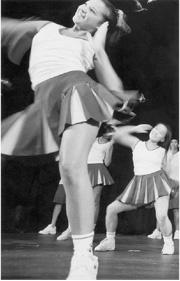THE MOST INSPIRED scene in Runaway Bride occurs in a movie within the movie—a video of an outdoor hippie wedding staged so perfectly that it feels like a cartoon parody on par with The Simpsons. Julia Roberts appears in a backless crocheted dress that shows off a rose tattoo, her hair adorned with white daisies. Several long-haired earth mothers click their cymbals and shake their tambourines. Julia jumps up and down on a trampoline printed with the Grateful Dead logo and falls into the arms of a jubilant blue-jeaned crowd, which then crowd-surfs her toward the groom. Then, instead of taking her vows, Roberts runs to a motorcycle and zooms away, abandoning the groom and signing a farewell with two fingers in a V.
RUNAWAY BRIDE
directed by Garry Marshall
starring Julia Roberts, Richard Gere, Joan Cusack
opens 7/30 at Pacific Place, Metro, Oaktree, others
This is perhaps the funniest scene in Roberts’ decade-long career, affording a rare glimpse of an actress capable of being much more than a giddy beanstalk if only she would allow herself. Too bad the rest of Runaway Bride, a script that Roberts and costar Richard Gere handpicked as a nostalgic nod to Pretty Woman (1990), isn’t half as good.
Indeed, that first movie—a sort of a streetwalker’s Cinderella—seems intelligent in comparison to the new one, which is little more than an oafish complaint against modern women. Richard Gere is Ike Graham, a Manhattan journalist who writes a first-person column for USA Today. His cynical essays on dating are urban affirmations of how men are from Mars and women are from hell. His latest piece of evidence: Maggie Carpenter (Roberts), a Maryland woman he hears about at a bar who’s left seven grooms at the altar and is now onto her eighth victim. Maggie is a praying mantis, the reporter asserts—just like the woman in the Hall and Oates song “Maneater,” which is soon played in the background: “Oh-oh, here she comes, watch out, boy, she’ll chew you up, oh-oh, here she comes, she’s a maneater.”
Ike publishes his hearsay about Maggie, causing a stir not only in her small, Mayberry-esque town of Hale, Maryland, but apparently among everyone on the streets of New York (as if anyone there reads USA Today). Furious, Maggie, who turns out to be a tomboy in denim overalls managing her father’s hardware store, writes to the paper’s editor in chief (Rita Wilson), informing her that the story is a gross fabrication. Soon, little old ladies are swatting Ike with their rolled-up newspapers, scolding him for the damaging slander. The editor, who also happens to be Ike’s ex-wife, fires the sloppy journalist for not checking his source. Jobless and hopeless, Ike drives to Maryland to meet the engineer of his demise, hoping to prove that what he’s written rings true after all.
The events I’ve outlined happen in the first 15 minutes or so. The rest of Runaway Bride follows an elliptical but predictable path toward proving that Ike had been right all along. Maggie is a maneater—though she hasn’t run from seven grooms, she’s left three, all of whom are now dog meat because of her. And now she’s about to crush a fourth man—a high-school football coach named Bob (Christopher Meloni). Of course, this being romantic comedy, Maggie starts falling for Gere’s Ike, who—as the perceptive, humbled, but very much virile ’90s man—turns out to be her undoing.
UNDER HOLLYWOOD’S TYPICAL surface treatment, a meaty social phenomenon— a woman fearing marriage rather than seeking it out the way evolutionary psychologists claim all of us baby-obsessed females do—is completely glossed over in favor of easy jokes and saccharine sentiment. Without addressing any of the underlying issues, much is made of Maggie as an incorrigible flirt, the daughter of a boozy father, and a woman who doesn’t know what kind of eggs she likes. Ike cites this last bit as clear proof that she’s “lost” and doesn’t know what she wants in life. At the end of the movie, the evolved Maggie decides how she likes her eggs cooked.
Runaway Bride does have a few isolated bright spots. While the story cries out for rewrites, some enjoyable performances are turned in by supporting actors. Hector Elizondo, who played the hotel manager in Pretty Woman, returns as a black-clad fashion photographer. Joan Cusack is wonderful as Maggie’s friend, Peggy. She of the thoughtful eyes and hesitant smile may have made a better runaway bride, but women who look like Cusack tend to hit Hollywood’s glass ceiling and spend their careers playing the Beautiful Woman’s Friend.
Is it too much to hope for more from Roberts? She may have gained her stardom through her figure and that trademark toothy smile as wide as a piano, but after 10 years of hit movies, she now possesses what is perhaps an unprecedented weight for an actress in the mainstream movie industry. This girl’s got a lot of power, and she could certainly choose better roles. But if Runaway Bride is any indication, Roberts really hasn’t come all that far.






